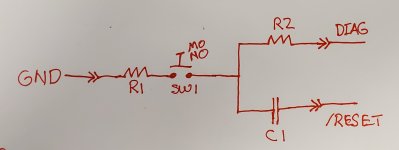Hi,
I have used something like this previously with other systems. Will it work? IDK. IF you have access to only the ground line and the DIAG and /RESET lines something like this "should" work, though I am waiting for the electrical engineers of the group to swarm and pounce once I post this:

R1 and R2 are for current limiting purposes, so can be something like 470 ohm, start with larger values and work down till you can trigger a reset condition with a short press. This will depend on the pullup resistors that keep these lines HI normally. IDK what those are. So some futzing is needed. Start with a larger value for C1 and work down, 22uF is a good guess. Large values will require a longer press to trigger the diag condition.
At power on, C1 is unbiased, and both DIAG and /RESET are driven high in tandem by their usual pullups.
A short press causes C1 to charge from /RESET. How fast it charges depends on the pullups on /RESET, R1 and C1. A short press biases C1 slightly, but not enough to maintain DIAG LO long after release.
A long press causes C1 to charge completely at which point the pullup for /RESET will drive /RESET HI, but DIAG is still driven LOW by you holding the switch. So if you keep pressing the system will reset - hopefully in diag mode. The time to reset can then be adjusted by using a larger / smaller C1 value. Releasing the switch at this point does not matter, /RESET is already high, C1 is biased to drive it high and drive DIAG LOW. So basically, "hold till diag" The time constant for the chosen C1 may be very long. So patience.
Also... will this work? IDK.



